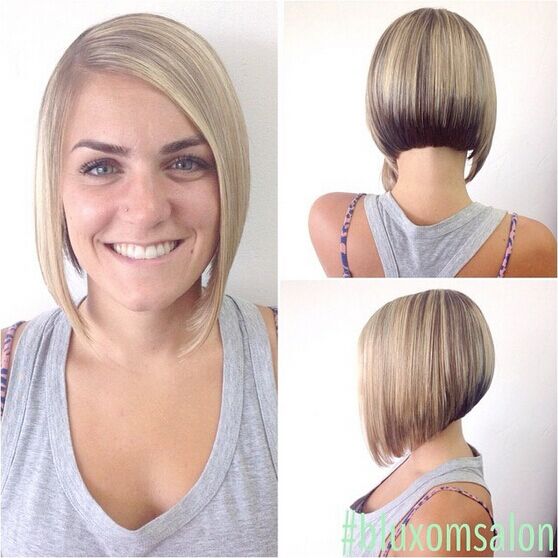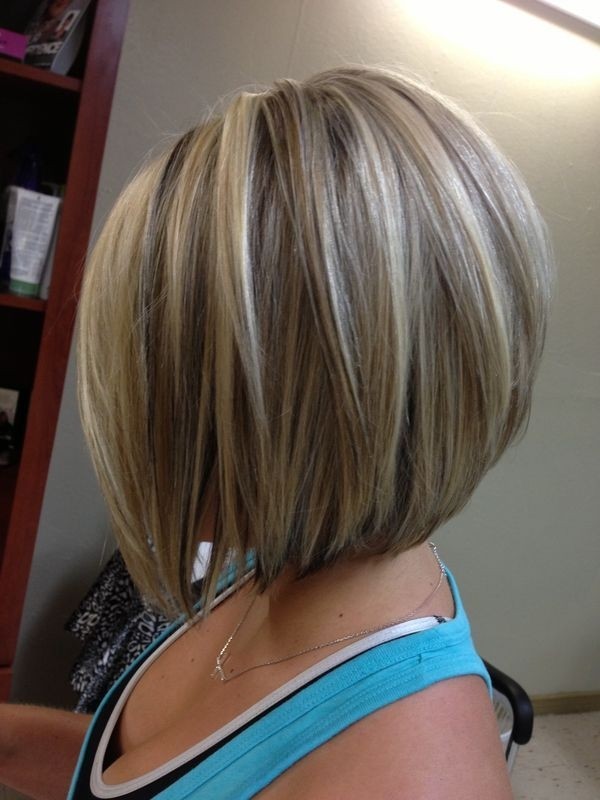 22 Popular Bob Haircuts for Short Hair Pretty Designshttp://www.prettydesigns.com/wp-content/uploads/2015/06/Inverted-Bob-Hairstyle-for-Women.jpg
22 Popular Bob Haircuts for Short Hair Pretty Designshttp://www.prettydesigns.com/wp-content/uploads/2015/06/Inverted-Bob-Hairstyle-for-Women.jpg
Bob Hairstyles Haircuts
A hairstyle, hairdo, or haircut refers to the styling of locks, usually on the individual scalp. Sometimes, this may also mean an editing of beard hair. The fashioning of hair can be viewed as an element of personal grooming, fashion, and cosmetics, although practical, cultural, and popular things to consider impact some hairstyles also. The oldest known depiction of hair braiding dates back about 30,000 years. In historical civilizations, women's locks was often elaborately and carefully dressed in special ways. In Imperial Rome, women wore their mane in complicated styles. From enough time of the Roman Empire[citation needed] until the Middle Ages, the majority of females grew their hair as long as it would obviously grow. Through the Roman Empire as well as in the 16th century in the western world, women started to wear their hair in extremely ornate styles. In the later half of the 15th century and on into the 16th century an extremely high hairline on the forehead was considered attractive. Through the 15th and 16th centuries, European men used their mane cropped no longer than shoulder-length. In the early 17th century male hairstyles grew longer, with curls or waves being considered desired.
The male wig was pioneered by King Louis XIII of France (1601-1643) in 1624. Periwigs or perukes for men were launched into the English-speaking world with other French styles in 1660. Late 17th-century wigs were lengthy and wavy, but became shorter in the mid-18th century, where time these were normally white. Short hair for fashionable men was a product of the Neoclassical movement. In the early 19th hundred years the men beard, and also moustaches and sideburns, made a solid reappearance. From 16th to the 19th hundred years, European women's hair became more visible while their wild hair coverings grew smaller. In the center of the 18th hundred years the pouf style developed. During the First World Battle, women around the world started to shift to shorter hairstyles that were easier to manage. In the first 1950s women's hair was generally curled and worn in a variety of styles and lengths. In the 1960s, a lot of women started out to wear their hair in short modern cuts such as the pixie cut, within the 1970s, mane tended to looser be longer and. In both 1960s and 1970s a lot of men and women wore their scalp very directly and long. Within the 1980s, women pulled back their hair with scrunchies. Through the 1980s, punk hair styles were adopted by some cultural people.
Throughout times, folks have worn their locks in a wide variety of styles, largely determined by the fashions of the culture they live in. Hairstyles are markers and signifiers of social class, age, marital status, racial identification, political beliefs, and attitudes about gender.
In many civilizations, often for religious reasons, women's head of hair is covered while in public, and in some, such as Haredi Judaism or Western european Orthodox communities, women's hair is shaved or slice very short, and protected with wigs.Only because the end of World Battle I have women started to wear their head of hair brief and in reasonably natural styles.
Paleolithic
- The oldest known duplication of head of hair braiding lies again about 30,000 years: the Venus of Willendorf, known in academia as the girl of Willendorf now, of a female figurine from the Paleolithic, believed to possess been made between about 28,000 and 25,000 BCE.The Venus of Brassempouy matters about 25,000 years of age and shows hairstyling indisputably.
Bronze Age
- In Bronze Age razors were known and in use by some men, but not on a regular basis since the technique was rather annoying and required resharpening of the tool which reduced its stamina.
Ancient history
- In historic civilizations, women's hair was often elaborately and carefully dressed up in special ways. Women coloured their hair, curled it, and pinned it up (ponytail) in a variety of ways. They arranged their hair in waves and curls using damp clay, that they dried in the sun and then combed out, or else by by using a jelly manufactured from quince seeds soaked in water, or styling tongs and curling irons of various kinds.
Roman Empire and DARK AGES
- Between 27 BC and 102 Advertising, in Imperial Rome, women wore their locks in complicated styles: a mass of curls at the top, or in rows of waves, drawn back into ringlets or braids. Eventually noblewomen's hairstyles grew so complex that they required daily attention from several slaves and a stylist to become maintained. The wild hair was often lightened using wood ash, unslaked lime and sodium bicarbonate, or darkened with copper filings, oak-apples or leeches marinated in wine and vinegar. It had been augmented by wigs, hairpieces and pads, and held set up by nets, pins, pomade and combs. Under the Byzantine Empire, noblewomen covered most of their hair with silk caps and pearl nets.
Best Hair Styles For Short Hair Women
- It is vital to choose the best short hair styles for ladies since it takes on a huge part of your style. Getting the right hairstyle can offer you with joy and positive thoughts. Find out which hairstyle is perfect for your personality and character. You should seek advice from your hairstylist before having a new haircut also. After all, changes are excellent and it can truly add positive view in your daily life also. Feel free to browse our collection of short hairstyles for girls and choose the one that your like best.
Most Trendy Bob Hairstyles 20142015 WardrobeLooks.com
 http://wardrobelooks.com/wp-content/uploads/2014/04/Most-Trendy-Bob-Hairstyles-2014-2015-2.jpg
http://wardrobelooks.com/wp-content/uploads/2014/04/Most-Trendy-Bob-Hairstyles-2014-2015-2.jpglong bob haircuts long bob hairstyles
 https://blogger.googleusercontent.com/img/b/R29vZ2xl/AVvXsEjiwBxfE2N665DQmK6SO7VguavyNVCYYYTGq0Y_7uaMLNkmWBTrhDUvSTZ6DCmf9EXI6lTqCHYiMTqVYIQ1icBJ_8f8JnWcRrVExqSO_0C3-K8O01ephbd3eRuni6TBE_YL36GokpkVD6A/s1600/Long_Bob_Hairstyle_5.jpg
https://blogger.googleusercontent.com/img/b/R29vZ2xl/AVvXsEjiwBxfE2N665DQmK6SO7VguavyNVCYYYTGq0Y_7uaMLNkmWBTrhDUvSTZ6DCmf9EXI6lTqCHYiMTqVYIQ1icBJ_8f8JnWcRrVExqSO_0C3-K8O01ephbd3eRuni6TBE_YL36GokpkVD6A/s1600/Long_Bob_Hairstyle_5.jpghairstyles like short trendy cuts pixie cuts choppy bob haircuts
 https://blogger.googleusercontent.com/img/b/R29vZ2xl/AVvXsEjuz8JArDwDfS6Vu9Vf2UFsCZMgpNxaxC3dgwfTExZnZBKw0rvjZVzJmdTCaJz76DSCD7l-OZ8fZ3zqhoJ2vUqy0jkZlHQ8gZrzly_-22evy2in4SnvsOE4fQeG4qoSqAxDV-bVKGhLl03h/s1600/Bob-Hairstyles-Modern-Classics-2.jpg
https://blogger.googleusercontent.com/img/b/R29vZ2xl/AVvXsEjuz8JArDwDfS6Vu9Vf2UFsCZMgpNxaxC3dgwfTExZnZBKw0rvjZVzJmdTCaJz76DSCD7l-OZ8fZ3zqhoJ2vUqy0jkZlHQ8gZrzly_-22evy2in4SnvsOE4fQeG4qoSqAxDV-bVKGhLl03h/s1600/Bob-Hairstyles-Modern-Classics-2.jpg30 Popular Stacked Aline Bob Hairstyles for Women Styles Weekly
 http://stylesweekly.com/wp-content/uploads/2014/12/Stacked-Bob-Hairstyles-Pictures.jpg
http://stylesweekly.com/wp-content/uploads/2014/12/Stacked-Bob-Hairstyles-Pictures.jpgOIP.M036e1a72692f14cddb8140c8e2eeb1f8o1
200AA826B350455F312AE176E4C30304CA6145FE59http://www.prettydesigns.com/22-coolest-bob-haircuts-for-short-hair/
Embed Our image to your website
ThumbnailImageEmbed Our image to a Forum
ThumbnailImage








.jpg)
.jpg)

